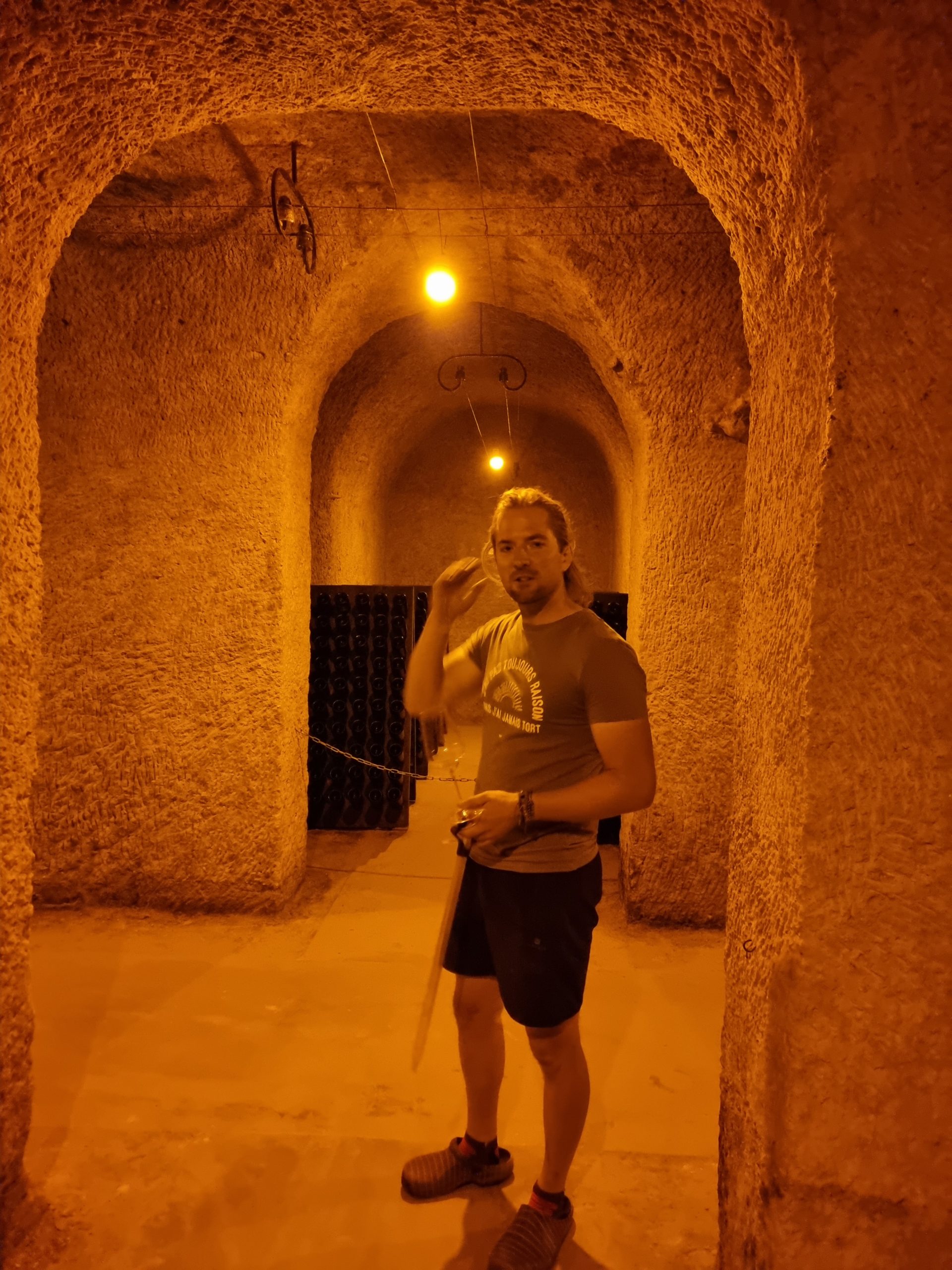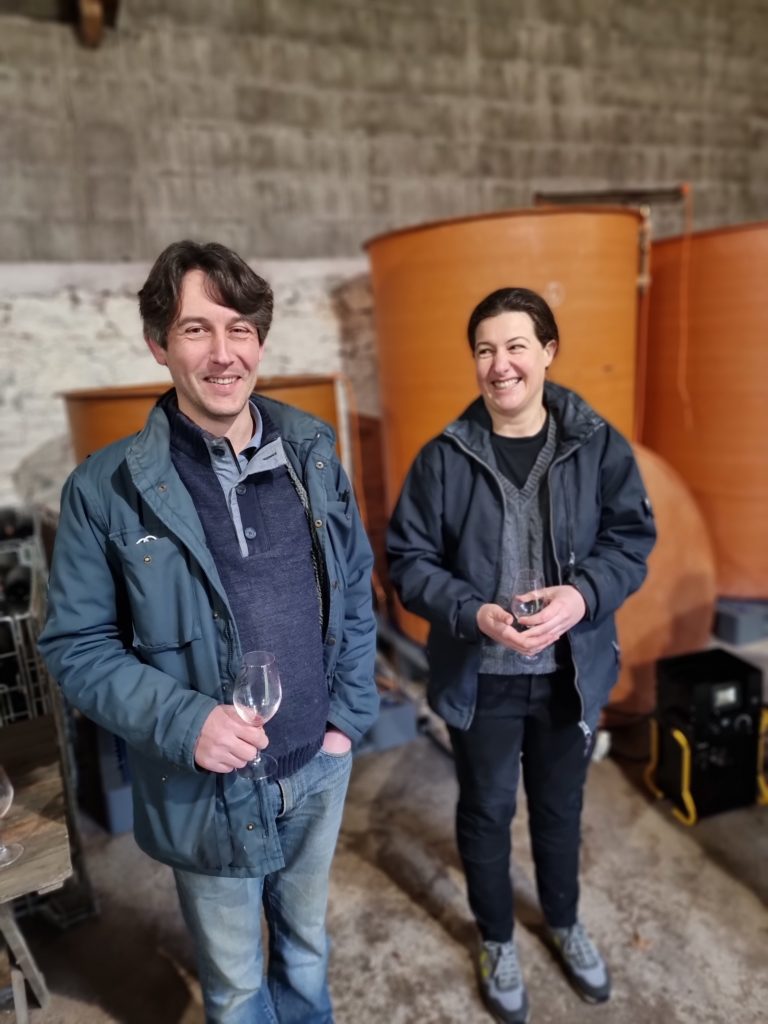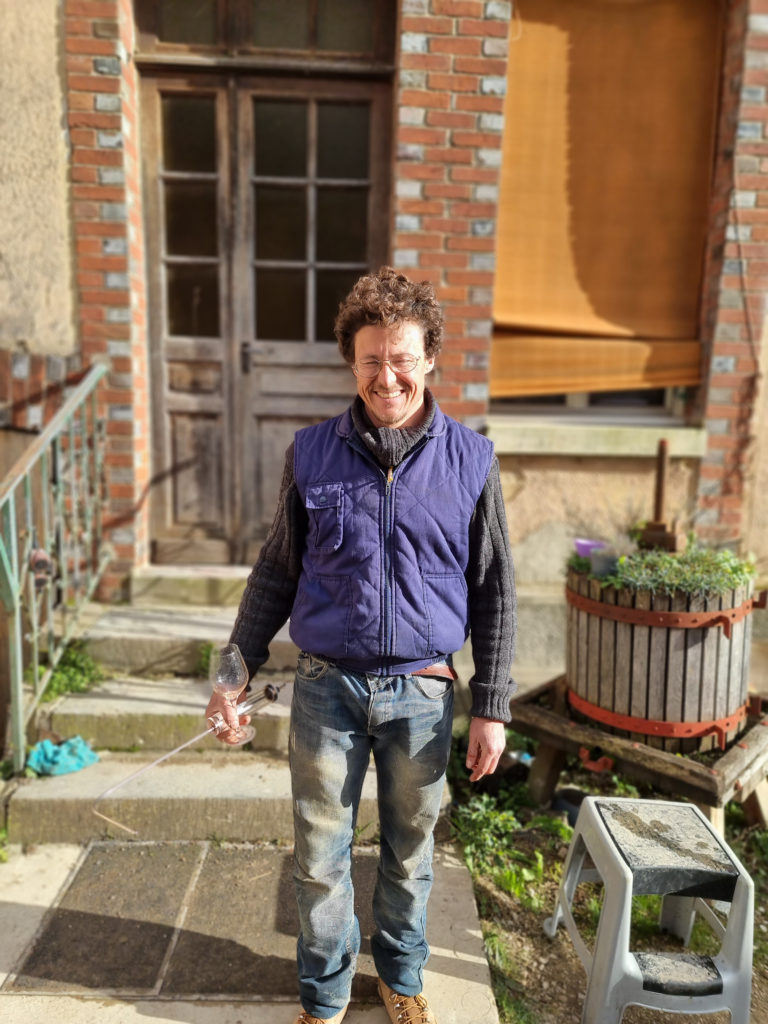Thibault LEGRAND – CHAMPAGNE LEGRAND-LATOUR

Tibault Legrand is a young champagne winemaker based in the commune of Fleury la rivière, in a counter-valley of the Marne to the north-west of Epernay.
He succeeded his grandfather at the head of the family vineyards in 2012. (As his father had devoted himself to studying fossils and drilling the Cave aux Coquillages, he sold the grapes to a cooperative in exchange for bottles).
Thibault looks after his 3.5ha of vines at Vandière and soon a plot planted above the estate at Fleury-la-Rivière.
The vines have been certified organic since 2019, and Thibault is also planting more and more trees and hedges, following the principles of agroforestry to encourage biodiversity in his vineyards.
In terms of vinification, the ripe grapes are pressed in two 2000kg Champagne press, the juice flows by gravity into a settling tank, and the wines are aged on fine lees in barrels. Fermentation takes place religiously in the cellars, 30 meters underground, thanks to the action of indigenous yeasts and without any inputs. The “vins clairs” are not manipulated, and some barrels even develop impressive yeast veils and marvellous oxidative aromas.
The sparkling process (Tirage) is carried out using a leaven made from fresh grape must from the following year’s harvest or frozen grape must from the previous year.
The corked champagnes are left to rest in the “Cave aux coquillages cellar to develop their aromas on lath until disgorgement 20 months later.
Each cuvée reflects the identity of a common geological subsoil. We find🐚 :
•Ypresien -56.0 to -47.8 million years old
•Eocene -56.0 to -33.9 million years old
•Campanien -83.6 to -72.1 million years old
•Lutetian -47.8 to -41.3 million years old
The champagnes are lively, incisive, and impressively complex.
Constantin VELLIS & Raphaëlle PIENNE – DOMAINE HELICON

Domaine Hélicon is located in Cornus in the Anjou Noir region, south of Angers. The estate’s name comes from Rabelais’ Tiers Livre: “Attendez un peu que je hume quelque traict de ceste bouteille: c’est mon vray et seul Helicon: c’est ma fontaine Caballine: c’est mon unicque Enthusiasme.”
Constantin Vellis and his partner Raphaëlle Pienne moved there in 2019 after leaving Paris for the peace and quiet of the countryside.
They started out with just under 2 hectares of vines (2.8 Ha from 2023), while keeping their former professions in parallel.
The vines are predominantly 40-year-old chenins on purple schist for the Guêpière terroir, which produces the Frênésie cuvée (the name is due to the quantity of ash trees growing on the plot), and 20-year-old chenins on grey-green schist for the Onglés terroir, which produces the Anicroche cuvée.
The 2021 vintage sees the arrival of a new cuvée made from Cabernet franc from Abel Benmaamar, vinified half in whole bunches and half destemmed. Following this trial, Constantin decided to take over a 60-acre plot in 2023, planted mainly with 50-year-old Cabernet Franc on the plateau behind the commune of Faye d’Anjou.
At Domaine Hélicon, harmony reigns. The vines are nurtured naturally, flourishing without chemicals, akin to a living garden. The grapes are pressed in vertical presses and put on fine lees in different barrels of different wines and species (oak and acacia). Fermentations take place naturally under the action of indigenous yeasts, then the wines are left untouched before being blended in “mass” for a few months and bottled. Only a small amount of SO2 may be used if need.
Small Yields. Big Passion. Unforgettable Wines.
The extreme quality of the domaine’s wines is due to the minute quantities produced and the constant attention paid to the wines.
At no time is there any mercantile thinking, only a focus on the quality of the final product.
The result is one of the most touching wines you’ll ever taste.
Taste the emotion, these are wines you’ll cherish
Aurelien LURQUIN – CHAMPAGNE LURQUIN

The Aurelien Lurquin estate is located in Romery, a small village at the foot of a cirque beneath the Reims mountain in the Marne Valley.
Aurélien took over his grandfather’s vineyards in 2007, which had been leased by his cousins for about fifteen years. The estate currently covers 2.8 hectares in Romery and Cormoyeux, of which only 1.80 hectares are vinified at the estate. The rest is still delivered to the Fleury cooperative or his cousins. It is probably one of the most intimate champagne estates. The grape varieties consist of 33% Pinot Noir, 31% Chardonnay, 36% Pinot Meunier, and a few Petit Meslier vines, with an average vine age of around 50 years. However, Aurélien vinifies 46% Pinot Noir, 33% Chardonnay, and 21% Meunier.
Becoming a winemaker was a natural choice for him, as he has been immersed in this world since his childhood. After starting his apprenticeship at a young age in Champagne, he gained experience in the Rhône, Chile, Burgundy, and Bandol.
Aurélien is a person characterized by humility and kindness, to the extent that it may seem suspicious how genuinely kind he is. A true child with innocent, shining eyes, a bit absent-minded, he might even forget your appointment. However, when it comes to his vineyard and wines, he is a perfectionist. No investment is too much when it comes to producing even better grapes. As for his vineyard, he is accompanied by his loyal horse Tintin, his cow Juliette, as well as his chickens, which were eaten by foxes, and his four little pigs that escaped into the surrounding woods.
The estate has been practicing unclaimed biodynamics since 2007 and has been certified organic since 2012. To encourage biodiversity and life in the plots, he practices agroforestry, spreads wood chips, and allows trees and shrubs that have grown wild in his vineyard plots to flourish.
Ski touring, paragliding, adventures, this is what drives his character, a thoughtful daredevil in love with the great outdoors and the mountains.
A complete character, his wines reflect his personality, and the great harvest celebration that takes place at the “House of Happiness” (the estate) is the embodiment of this. Every year, a group of loyal followers gather to share a timeless moment and accompany Aurélien in his quest for the finest grapes.
The grapes are harvested in small 10kg crates to keep the clusters intact and minimize handling. They can be cooled in a cold room if necessary, and then they are pressed in a traditional 2000kg Coquard press. The pressing is very long and gentle. The juice flows by gravity, with some used for the sparkling wines and the more aromatic parts used for the still Coteaux Champenois wines.
They are 100% aged in oak barrels, just like his grandfather used to do, with no added sugar and very little or no sulfur dioxide used.
The estate only produces 1 to 5 barrels per cuvée (300 to 1500 bottles), and each wine has its own identity, reflecting Aurélien’s desires. He now wishes to extend the aging of his clear wines to 2 years in barrels.
We’ll have to wait a few years to taste all of this.
